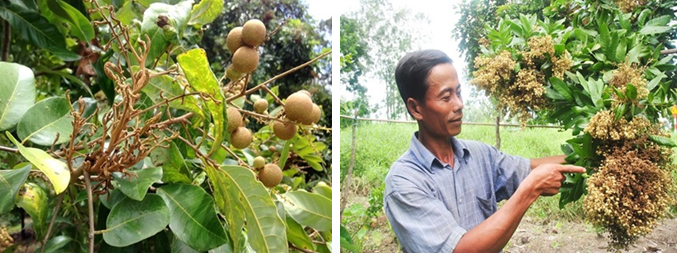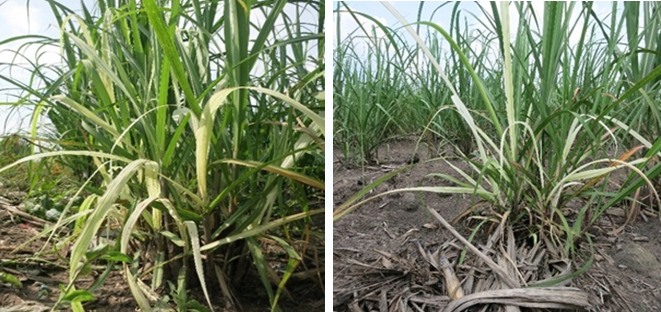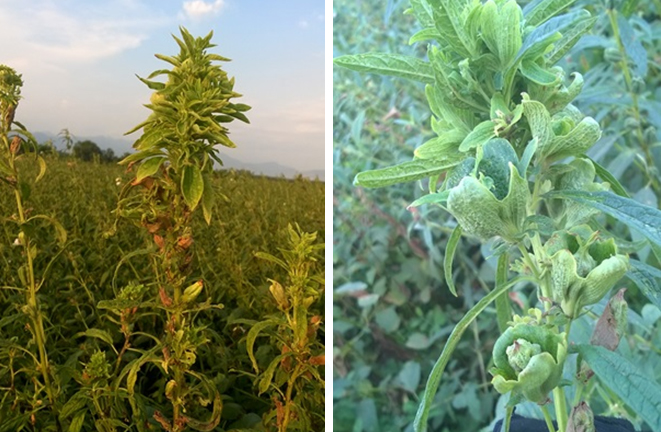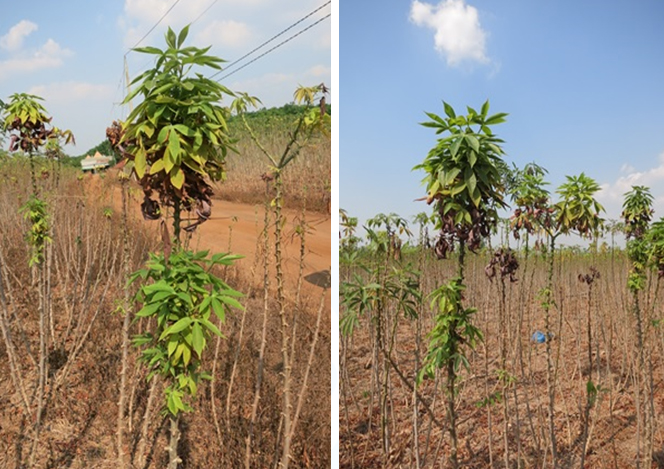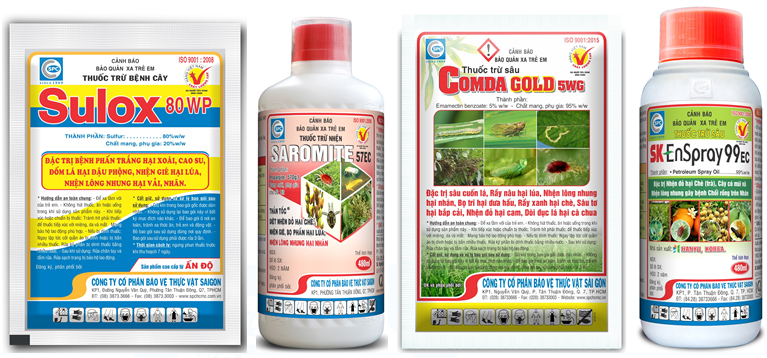|
Phytoplasma disease on some plant types
29/01/2022
BSc Nguyen Kha Minh Tuan Discovered more than half a century ago, Phytoplasma is the causative agent of many diseases on many different crops such as: " ruffled unicorn is head " disease on sesame, "white leaf" disease on sugarcane, "witches broom disease" on longan, " witches broom disease " or "dragon is head" on cassava, etc. But so far, humans have not found any plant protection products or preparations that can treat diseases caused by these effects. caused by this agent. Phytoplasma is microscopic in size (diameter ± 500 nm), known as a cytoplasm without cell walls and nuclei, which can exist in a variety of shapes. Phytoplasma is difficult to detect because of its small size and limited presence in the cell tissue Life cycle and transmission: The life cycle and transmission of Phytoplasma is through 3 main stages: (1) Phytoplasma from plant phloem infecting insects; (2) Phytoplasma proliferates in the salivary glands of insects; (3) Phytoplasma dispersal from insect to next host plant (Weintraub et al., 2006). The damage caused by Phytoplasma on crops is increasingly serious. They spread rapidly by grafting, clonal cuttings, dodder and insects. The damage of the disease is like a plant virus disease, Phytoplasma causes plant degeneration leading to yield and quality reduction, plants gradually dying. Symptom: Phytoplasma interferes with plant growth shown through typical symptoms including: Phyllody (flowers turn into leaves), Virescence (instead of normal color, flowers develop green pigment), Witches -broom (dense growth of shoots from a single point), abnormal number of hair roots, inhibited flowering, stunted plants, wilt (Bertaccini, 2007; Hogenhout et al., 2008).
Symptoms of witches broom disease on longan
Symptoms of cane leaf white disease
Symptoms of ruffled unicorn is head disease on sesame plant
Symptoms of witches broom disease on cassava Some measures to manage diseases caused by Phytoplasma: Because there is no specific medicine to treat and prevent directly Phytopplasma from harming plants, some measures are mainly applied to prevent indirect diseases caused by Phytoplasma as follows: - Use disease-resistant varieties, disease-free varieties. - Sanitize the field, collect and destroy infected plants in the field. - Clean tools and farming tools with alcohol or formol, etc. - Crop rotation is not the host. - Regularly visit fields to detect and destroy diseased plants in a timely manner. - Prevention and control of insects that feed on disease vectors such as: villous spider (Eriophyes dimocarpi) on longan, gray hopper (Hishimonus phycitis) on cassava, hopper (Matsumuratettix hiroglyphicus) on sugarcane and insects on sesame . + For villous spider that transmit witches broom disease on longan, use the products: SK enspray 99EC mineral oil, Sulox 80WP, Saromite 57EC, Comda Gold 5WG (do not mix SK with the mentioned products, except Comda Gold). Spray the plants evenly when the longan sprouts buds + For the hopper that transmits witches broom disease to cassava, hopper transmits cane leaf white disease and vector transmits ruffled unicorn is head to sesame, you can use product mixtures: Sairifos 585EC + SK Enspray 99EC Mineral oil or Sairifos 585EC + Butyl 400SC or spray Sec saigon 25EC - Strengthen propaganda and training works for farmers. |
To prevent, in addition to plowing and burying weed seeds, collecting weed stalks and stumps left after tilling the land to burn, not letting weeds produce seeds in production fields, etc., the use of chemical products is still a measure. optimal because of its ability to thoroughly kill weeds, reduce labor and take advantage of more time than manual weeding.
Miner has the scientific name Phyllocnistis citrella Staint., family Phyllocnistidae, order Lepidoptera. The miner occurs in many countries in the tropics and subtropics. The main host of the miner is the citrus family - Rutaceae. In addition, the miner also attacks mangosteen and some other plants.
Adult is a small planthopper, with a body 2-3 mm long, the whole body is ash gray, slightly greenish, the wings are opaque with many small brown spots.Eggs are oval, 0.3 mm long, have a pointed end and are attached directly to the leaf surface, leaf axils.
Green bugs specialize in the fruit of citrus groups (oranges, tangerines, lemons, grapefruits, kumquats...), some people call them orange bugs, or orange suckers. Their scientific name is Rhynchocoris poseidon or Rhynchocoris humeralis.
In Vietnam, yellow leaf curl disease is very common on papaya trees, especially the disease is often severe in areas of high and continuous planting, areas with hot and arid climates. The disease has significantly reduced the yield and quality of papaya. Gardens that are infected early when the plants are young may not yield. However, up to now, many gardeners still do not know the cause and how to fix it.
Spider mites are common pests on citrus trees, especially in hot and dry climates that are suitable for spiders to grow and cause severe damage.The group of harmful spiders is usually very small in size, unlike the natural enemy spiders.
This group includes species that are generally very small in size, causing damage by sucking plant sap (on leaves, fruits, branches, stems).
There are many species of mealybugs present on the group of Oranges,Tangerines,Grapefruits and Lemons (Citrus), which can be divided into 2 groups:
+ Group of sticky mealybugs with common varieties such as Lepidosaphes, Aonidiella, Coccus and Saissetia.
+ Group of flower mealybugs with common genera and species such as Pseudococcus, Planococcus and Icerya purchasi.
Dry branches and berries disease often appear to be common damage on coffee gardens during the rainy season. The disease causes death of branchs, dry fruit, severely affects the canopy structure and coffee yield if not paid attention to prevention.
Pink disease commonly causes diseases on rubber plantations in the rainy season, especially on garden from 4-8 years old. This year, rubber has to go through a period of severe drought, weakening the tree, so now in tnshe rainy season it is easy to get infected. Therefore, it is necessary to pay attention to good management to avoid affecting the garden.
In recent years, the area of citrus has been expanded because it is a fruit tree with high economic efficiency. However, in order to sell at a high price, not only in quality but consumers also require the external beauty of the fruit, so pest management on citrus is a matter of great concern to farmers. The hot season is a favorable condition for thrips to develop and cause damage, affecting the commercial value of fruit.
- Headquarters
- SAIGON PLANT PROTECTION JOINT STOCK COMPANY
- RQ 1, Nguyen Van Quy St., Tan Thuan Ward, HCM City
- Tax code: 0300632232
- Tel: (028) 38 733 295 - 38 732 077
- Fax: (028) 38 733 003 - 38 733 391
- Website: www.spchcmc.vn - Email: info@spchcmc.vn
- SAIGON PLANT PROTECTION COMPANY
- SAIGON PLANT PROTECTION JOINT STOCK ENTERPRISE
- Lot C1-C3 Hiep Phuoc Industrial Park, Hiep Phuoc Commune, HCM City
- Tel: (028) 3873 4089 - Fax: (028) 3873 4086
- Affiliated Unit
-
- Quick Links
- Home
- About us
- Career Opportunities


